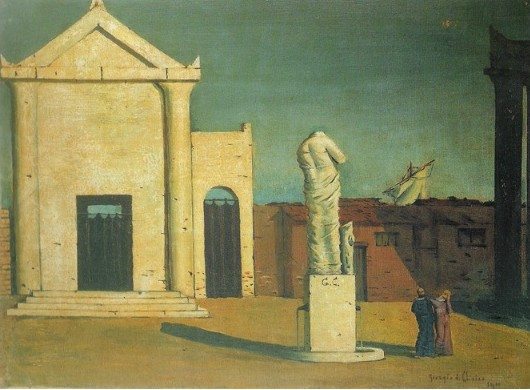Geogrio De Chirico
Georgio De Chirico was a Greek born Italian painter. He was born in 1888, in Volos, Greece. He studied at Athens Polytechnic, mainly under the guidance of the influencial Greek painters, Georgios Roilos and Georgios Jackobides. In 1906, he moved to Germany, following his fathers death the year before, and entered the Academy of Fine Arts in Munich, where he studied under Max Klinger, and read the writings of the philosophers Nietzche, Arthur Schopenhauer, and Otto Weininger. He also studied the works of Arnold Böcklin.
In the summer of 1909, he traveled to Italy, and spent 6 months in Milan. He moved to Florence in the beginning of 1910, where he painted his first of his Metaphysical Town Square series, The Enigma of an Autumn Afternoon.
In 1911, he spent a few days in Turin while on his move to Paris. There, he was profoundly moved by the 'metaphysical aspect' of Turin, especially the architecture of its archways and piazzas.
In the years leading up to WW1, he founded the Scuola Metfisica art movement, which served as profound influence for the Surrealists.
After the outbreak of WW1, he returned to Italy. Upon his arrival in 1915, he enlisted in the army, but was considered unfit for work, and was assigned to the hospital in Ferrera. Here, he met Carlo Carrà, and together, the founded the Pittura Metafisica Movement. He continued to paint, and in 1918, was transferred back to Rome.
Starting from 1918, his artwork was exhibited extensively through Europe. He is best known for his paintings he produced between 1909 and 1919, his metaphysical period, which are characterized by haunted, brooding moods evoked by their images. At the start of this period, his subjects were still city-scapes inspired by the bright daylight of the Mediterranean cities, but he gradually turned his attention to studies of cluttered store rooms, sometimes inhabited by mannequin like hybrid figures.
After 191, he became interested in traditional painting techniques, and worked in a neoclassical or neo-Baroque style, which frequently revisited the Metaphysical themes of his earlier work.
In the summer of 1909, he traveled to Italy, and spent 6 months in Milan. He moved to Florence in the beginning of 1910, where he painted his first of his Metaphysical Town Square series, The Enigma of an Autumn Afternoon.
 |
| The Enigma of an Autumn Afternoon 1910 |
In the years leading up to WW1, he founded the Scuola Metfisica art movement, which served as profound influence for the Surrealists.
After the outbreak of WW1, he returned to Italy. Upon his arrival in 1915, he enlisted in the army, but was considered unfit for work, and was assigned to the hospital in Ferrera. Here, he met Carlo Carrà, and together, the founded the Pittura Metafisica Movement. He continued to paint, and in 1918, was transferred back to Rome.
Starting from 1918, his artwork was exhibited extensively through Europe. He is best known for his paintings he produced between 1909 and 1919, his metaphysical period, which are characterized by haunted, brooding moods evoked by their images. At the start of this period, his subjects were still city-scapes inspired by the bright daylight of the Mediterranean cities, but he gradually turned his attention to studies of cluttered store rooms, sometimes inhabited by mannequin like hybrid figures.
After 191, he became interested in traditional painting techniques, and worked in a neoclassical or neo-Baroque style, which frequently revisited the Metaphysical themes of his earlier work.
 |
| The Uncertainty of the Poet 1913 |
.jpg)
No comments:
Post a Comment